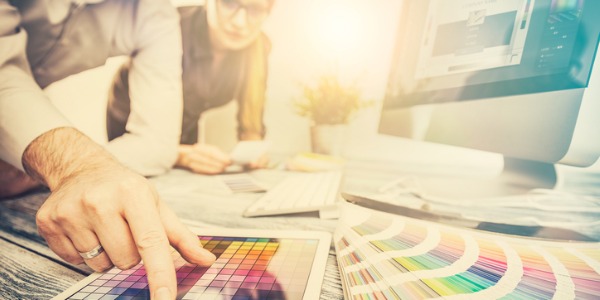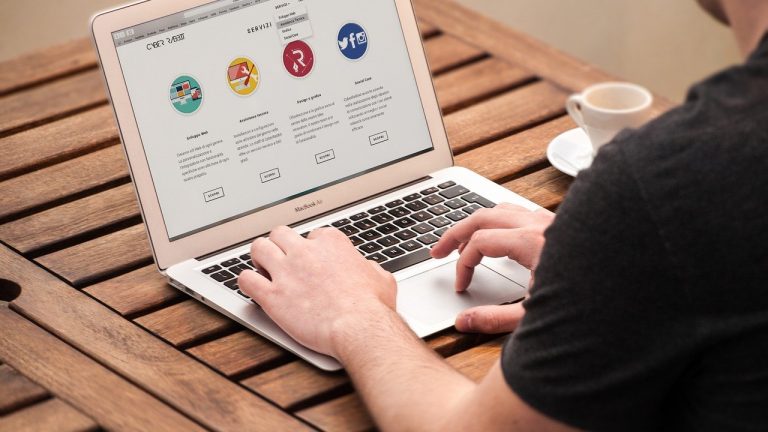What is a Graphic Designer?
Graphic design is also known as communication design. Graphic designers are visual communicators, who create visual concepts by hand or by using computer software. They communicate ideas to inspire, inform, or captivate consumers through both physical and virtual art forms that include images, words, or graphics.
The end goal of graphic designers is to make the organizations that hire them recognizable and prominent. By using a variety of media they communicate a particular idea or identity to be used in advertising and promotions. These media include fonts, shapes, colors, images, print design, photography, animation, logos, and billboards. Graphic designers often collaborate on projects with artists, multimedia animators, and other creative professionals.

So, every graphic designer is a visual-thinking problem solver and communicator. Every graphic designer is charged with the task of solving specific communication challenges and achieving specific creative outcomes. But this does not fully answer the question, What is a graphic designer? Why? Because, depending on your role as a graphic designer, you may be:
A Creative Director You manage a creative team that creates visuals for product branding, advertising campaigns, etc.
An Art Director You manage and coordinate between production artists and illustrators to make sure projects are completed on time and to the client’s satisfaction.
An Art Production Manager You manage the production aspect of art generation and creation, with a focus on improving efficiency and lowering costs.
A Package Designer You create and design packaging for marketing and/or products in terms of both design and physical construction.
A Brand Identity Developer You develop brand identities for various organizations.
A Visual Image Developer You create images and designs through 3D modeling, photography, and image editing.
A Visual Journalist Among other things, you create informational graphics known as infographics. This can be for print or digital application.
A Broadcast Designer You create visual designs and electronic media to be used in television productions.
A Logo Designer You create the visual expression of the organization’s key message or value. This is also a key aspect of brand identity – though in identity design, you carry the logo and design identity forward for all branding materials.
An Interface Designer You develop graphical user interfaces and usually work for web development companies.
A Web Designer You create graphics, layouts, and pages for websites.
A Multimedia Developer You apply graphic design skills to sound and/or motion.
A Content Developer You create written, graphical, video, sound, or other multimedia content depending on your brief.
What does a Graphic Designer do?
Graphic designers combine art and technology to communicate ideas through images and the layout of web screens and printed pages. They may use a variety of design elements to achieve artistic or decorative effects. They develop the overall layout and production design for advertisements, brochures, magazines, and corporate reports. Graphic designers work with both text and images. They often select the type, font, size, colour, and line length of headlines, headings, and text. Graphic designers also decide how images and text will go together on a page or screen, including how much space each will have. When using text in layouts, they collaborate closely with writers who choose the words and decide whether the words will be put into paragraphs, lists, or tables. Their work typically involves the following:
- Meet with clients or the art director to determine the scope of a project
- Advise clients on strategies to reach a particular audience
- Determine the message the design should portray
- Create images that identify a product or convey a message
- Develop graphics and visual or audio images for product illustrations, logos, and websites
- Create designs either by hand or by using computer software packages
- Select colours, images, text style, and layout
- Present the design to clients or the art director
- Incorporate changes recommended by the clients into the final design
- Review designs for errors before printing or publishing them
Graphic design is becoming increasingly important in the sales and marketing of products. Therefore, graphic designers, also referred to as communication designers, often work closely with people in advertising and promotions, public relations, and marketing. Frequently, designers specialize in a particular category or type of client. For example, some create credits for motion pictures, while others work with print media and create signs or posters.
Graphic designers must keep up with new and updated computer graphics and design software, either on their own or through formal software training programs. They must be able to create designs that are artistically interesting and appealing to clients and consumers. They produce rough illustrations of design ideas, either by hand sketching or by using a computer program.
Graphic designers must communicate with clients, customers, and other designers to ensure that their designs accurately reflect the desired message and effectively express information. Most use specialized graphic design software to prepare their designs. They must be able to think of new approaches to communicating ideas to consumers. They develop unique designs that convey a recognizable meaning on behalf of their clients.
Graphic designers often work on projects with other graphic designers and marketers, business analysts, writers, and programmers. They must collaborate to produce successful websites, publications, and other products. Some individuals with a background in graphic design teach in design schools, colleges, and universities.
What is the workplace of a Graphic Designer like?
Generally speaking, graphic designers work in one of three work environments. Therefore, the answer to this question depends on the option you choose.
Working as an in-house graphic designer
Working in-house means that you are employed with an established organization and your work revolves around a single brand or a single group of related brands. Graphic designers in these kinds of roles tend to be generalists. They possess a broad range of general design skills so that they are able to meet all the creative needs of the company.
Advantages of working in-house
– Perks of a traditional work environment: separation of home and work; collaboration with colleagues in a social workplace; company benefits
– A steady paycheck: stability without having to build up a clientele
– Opportunities to advance: potential to climb the corporate career ladder
– One brand or brand set to develop: singular focus allows designers to develop an in-depth understanding of the organization’s brand, style, and target audiences; opportunity to build a long-term strategy and see the results that it yields.
Disadvantages of working in-house
– More rules: an established company brand can feel restrictive; it requires that you come up with new ideas while adhering to brand guidelines
– More communication: you will likely have to explain and justify your designs to non-designers
– A non-design environment: office space may not be optimized with the designers in mind; there will be fewer, if any, fellow designers to collaborate with
Working as an agency graphic designer
Graphic design agencies are hired by outside clients to produce creative work. In this environment, designers typically work with an assortment of brands. Assignments tend to be short-term, project-base, and limited to a specific campaign.
Advantages of working at an agency
– Expectation of design excellence: managers and coworkers who are designers and/or familiar with the design world; high expectations of professionalism; diverse opportunities to advance your design skills; generally fewer communication delays than may occur when working with non-designers
– Established processes and mentors: agencies tend to have their processes and systems streamlined, as well as senior designers on staff, which creates productive learning environments for new designers
– Focus on graphic design: non-design tasks are extremely rare; daily work is always within the realm of graphic design
Disadvantages of working at an agency
– Less job security: agencies hire staff to match the contracts they have; if the project list dips, there is a risk of lay-off due to the need to reduce the number of graphic designers
– Rigorous hours: Agency settings are fast-paced, with tight deadlines; occasional late nights to finish a project are not uncommon
Working as a freelance graphic designer
Freelance graphic designers are responsible for more than just graphic design. They are responsible for every aspect of their business, from marketing and client relations to bookkeeping and invoicing. The role calls for considerable self-discipline and dedication.
Advantages of working as a freelancer
– Location: no commuting; flexibility to work from anywhere with Wi-Fi
– Creative freedom: creative flexibility; select work that challenges and inspires you
– A tailored schedule: tailor your hours to the lifestyle you want, as long as you keep up with the workload and remain productive
Disadvantages of working as a freelancer
– No coworkers: essentially, you will be working alone in relative isolation, in a non-collaborative environment, which may at times challenge your motivation
– Hunting and bidding for work: projects will not land on your desk; you will have to actively seek – and sometimes compete to win – projects
– Unreliable pay without benefits: pay can vary dramatically from month to month, depending on the flow of work; health insurance, maternity leave, and retirement accounts will be your own responsibility

Frequently Asked Questions
What is some good advice for graphic design students?
It’s important to love the whole design process, from beginning to end. Make sure to keep updated with any changes in the industry; it moves at a fast pace. Having said that, don’t blindly follow trends leaving great ideas behind. Doing design for the sake of design is not the way to go.
Sometimes you’ll become overly invested in a design you’re working on, so much so that you become defensive if it’s criticized. Don’t get overly sensitive about criticism – keep your mind open to suggestions. Just because someone doesn’t like your work doesn’t mean you are a bad designer.
Invest in your portfolio, and be selective in what goes in it. Focus on your best pieces, and make them as impressive as you can make them. Employers will often ask you to explain what’s in your portfolio and why it’s in there, so make sure you can explain why you included each piece.
Do graphic designers need to have the ability to draw?
What is the difference between a graphic designer and an illustrator?
Both graphic designers and illustrators do design-type work.
Graphic designers will work on design elements and structures, providing a visual message/brand for a company in order to sell a product or service.
Illustrators, on the other hand, will typically do commercial work for companies like comic book houses, publishing houses and advertising agencies. They do a lot more drawing, designing of product packaging, working on book illustrations, creating company logos, and graphic novels.
Graphic design degrees require a concentration in product design, website design, and publication design. Illustration students have some graphic design training, but most of their coursework includes art history, drawing, and painting. The illustrator doesn’t have the advanced knowledge of a graphic designer.
If you like to draw and illustrate concepts, illustration would be a good fit. If you prefer to code, make websites, and do detail-type work, then graphic design might suit you better.
Do Graphic Designers need to be able to code?
Graphic designers work with all types of media. Their designs are printed on paper, silk screened onto signage, and displayed on screens as an app or website, to name just a few. Understanding what is and isn’t possible in the intended medium is crucial to creating an effective design.
So, yes, designing for digital media like websites and apps requires understanding what you can and can’t do with code. Knowing how to code a website on your own isn’t necessary, just understanding the high level concepts and being able to have a conversation with developers is enough.
You can sketch almost anything, and while that freedom can be an important part of the creative process, a designer knows that for any project, success depends on well defined constraints. Learning about the limitations of your medium is an essential part of being a designer, but you don’t need to “write the code” yourself.
What are the biggest differences in designing for print versus the web?
Designing for the web introduces a whole host of new variables, limitations, and opportunites that aren’t present in print design.
While print design usually means designing for fixed layouts where the designer knows exactly how the content will be displayed to users, web design requires taking into account the fact that users can be viewing their content on a variety of devices, each with different pixel densities, color profiles, and screen ratios. Often times, this also means designing for fluid experiences, where designs must be able to react to changes in screen size and page events, presenting new design challenges.
Futhermore, the technical constraints are higher in designing for the web, where the designer is expected to know what is and isn’t possible with current technologies. For example, web typography is still in its infancy: many standard typographical tools aren’t available or easily accessible, and some foundries still do not license their typefaces for use online. In addition, bandwidth constraints require designers to also take things like filesize into account, sometimes restricting design opportunities in the name of a better user experience.
Designing for the web, however, also brings with it interactive elements that aren’t present in print design, which offers up many new possibilities, but creates more work for the designer. For example, it opens the door to adding animations and transformations to page elements, but that also introduces user-experience as a new goal for designers to worry about. Whereas with print design there is usually little user interaction, on the web it becomes a primary concern to the designer, creating a new lens through which they must look at their work.
What is it like being a graphic designer?
Working as a graphic designer is not as glorified as many would think. It can be a stressful, cutting edge career, where one has to wear many different hats and face challenges daily. The industry technically and creatively evolves faster than almost any other industry, so graphic designers have to constantly stay on top of trends, learn new software, consistently stay creative, and come up with intriguing concepts and designs that will capture the minds and emotions of those who view the work.
A huge part of a graphic designer’s job is being intuitive and attentive to the client’s needs; being able to see through what they are saying vs what they are really saying (or meaning). It takes more than artistic ability to be a good designer; it takes excellent communication skills to understand and manage the client’s expectations and criticisms. Developing client-related skills, and making the design process about them and their product (and keeping your ego out of your work) will set you above many other graphic designers.
Where can one find graphic design inspiration?
Sometimes it’s hard to find the inspiration to create a unique work of art for a client. One thing that you can do to help open up your creative mind is to put yourself in the customer’s shoes. What would persuade you (as a customer) to buy the service or product? Why are you buying it (is it a need or a want)? The one and only mission that a graphic design has is to sell the client’s service or product (they act like visual salesmen). So if you can come up with an idea which would compel you (yourself) to buy, then you are definitely on the right track.
You can also look at how past graphic designers have dealt with similar products or services, and their creative work may spark some new ideas in you. Doodle design ideas over and over again until a solid design starts to show itself.
Should I become a Graphic Designer?
‘Should I become a graphic designer?’ Perhaps the best way to answer that question is with another question: What makes a great designer?
While there is no singular formula, there are most definitely some qualities which successful graphic designers tend to share. They combine sharp analytical skills with artistic talent to produce convincing illustrations that clearly relate to their clients’ messages. They have the capacity to critique their own work and recognize that they ‘are not quite there yet.’ Although they spend some time developing ideas on paper, they are comfortable utilizing specialized graphic design software. They develop sharp interpersonal skills, as they spend a significant amount of time communicating with clients and coordinating work with members of a design team. In addition, in an industry that typically involves completing multiple projects simultaneously, they are expert time manager. Above all, and not unexpectedly, graphic designers are visual and imaginative thinkers. They know how to best use digital tools to solve business challenges and creatively use the space they have to make the greatest impact.
A few more things to know about working as a graphic designer:
Learning will be a daily thing. The work of a graphic designer is work that never stops evolving or improving. The evolution and improvement, as in many other fields, come from making mistakes; from getting bad in order to be good. Simply stated, design is a never-ending whirlwind of discovery, invention, and reinvention.
Design will always be in demand. In the age of automation, when we are constantly being told that our jobs will one day be taken over by robots, you can rest assured that graphic design will always require human thinking and creativity. They are essential cogs in this industry. From simple business cards and printed materials, to packaging, websites, and advertisements, every brand and every business relies on visual communication. And it takes a designer to imagine all of the possibilities.
Design opens up many different career paths. As a graphic designer, you will be able to add value to any workplace, not just a design studio. If an agency isn’t quite right for you, you might want to venture into editorial design and work for a major publisher. Or join an internal team at one of the world’s biggest sports brands? Your career path is open to many different and exciting routes.
You will almost always work as part of a team. Graphic designers rarely work alone. They are often part of a creative team collaborating with clients to come up with the best possible solution. Your professional circle will invariably include PR specialists, copywriters, marketers, and advertisers. You will probably consult with senior management and company directors. Your role will rely on establishing and sustaining many business relationships and dealing effectively with different personalities.
Your career path is unpredictable. Graphic design can take you to places you never thought possible. You could secure a job at a studio in your home city or on the other side of the world. Your work may require that you travel to far flung places. You might go solo and launch your own studio. The possibilities are as numerous as design is creative.
You could see your work in lights. How would you feel if you spotted your work on a billboard? Or in a magazine? Seeing your creativity up in lights for everyone to see can be overwhelming. Imagine the sense of job satisfaction and the feeling of contributing to something that you know will inspire many people.
The way you see the world will change. When you walk down the street as a graphic designer, you’ll see things in a completely new light. Your job will become your life – in a fun way – and you’ll find inspiration in everything you see and do, saving ideas for your next project. Design brings a new perspective; it encourages you to get out there and discover new things. Architecture, art galleries, clothing, accessories; everything in your life will be full of creative wonder.
You will never stop being inspired. Design trends will evolve and change and keep you on your toes from one day to the next. You will never know what’s just around the corner. Design will never bore you. It will always leave you inspired. It will often stir you.
Steps to becoming a Graphic Designer
The work of a graphic designer is perhaps the pinnacle of combining the technical and the practical with the artistic and the creative. This multifaceted profession calls for both career-long learning and ongoing exploration of the relationship between cohesive design and human experience.
Are Graphic Designers happy?
Graphic designers rank highly among careers. Overall they rank in the 67th percentile of careers for satisfaction scores. Please note that this number is derived from the data we have collected from our Sokanu members only.
The high happiness quotient in the graphic design industry may be rooted in the endless opportunities it presents to its practitioners to imagine, to create, to collaborate, to inspire, and to see their work on public display.
What are Graphic Designers like?
Based on our pool of users, graphic designers tend to be predominately artistic people. While this comes as no surprise, given the visual and creative nature of their work, it should be noted that graphic designers must also cultivate refined analytical, communication, computer, and project management skills. Logically, their investigative and enterprising scores are next highest on the interest archetype scale. Part of their art, it seems, is being adaptable and versatile.
How long does it take to become a Graphic Designer?
Prospective graphic designers can prepare for their career by earning a two-year Certificate or Associate’s degree or a four-year Bachelor’s. The latter is the more common option. Those wishing to compete for high-level positions in the field may consider an additional two to three years of study to complete a Master’s program.
Source: https://www.careerexplorer.com/careers/graphic-designer/





